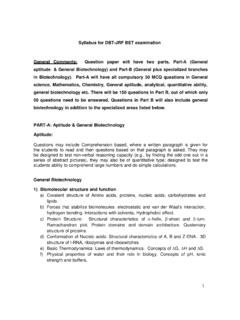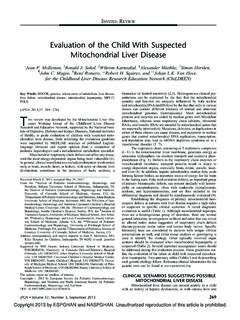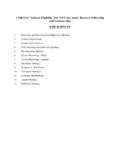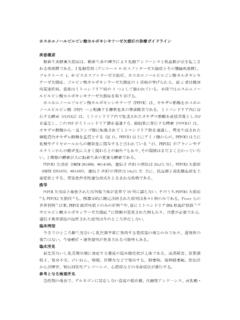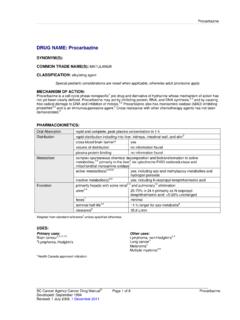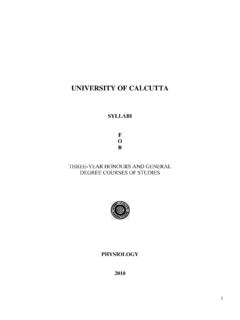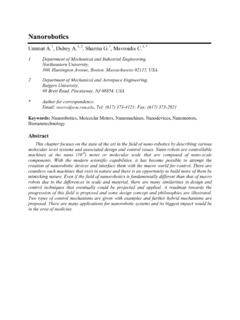Transcription of 9. M.Sc. (Marine Biotechnology)
1 CONTENTS. Title Credits Page No. SEMESTER - I. 1. Biochemistry .. 3 1. 2. Analytical Techniques & GLP .. 3 2. 3. Cell & Developmental Biology .. 3 3. 4. Molecular Biology .. 3 4. 5. Marine Bioresources, Biodiversity & Oceanography .. 3 5. 6. Seminar/Journal Club/Assignment .. 1. 7. Lab I-Biochemistry and Analytical Techniques .. 4 6. 8. Lab II-Molecular Biology & Oceanography .. 4 7. Total .. 24. NON-CREDIT COURSES. 1. Introductory Mathematics .. 8. 2. Communication Skills .. 8. SEMESTER - II. 1. Immunology .. 3 10. 2. Marine Microbiology .. 3 11. 3. Genetic Engineering .. 3 12. 4. Genetics, Genomics & Proteomics .. 3 13. 5. Aquaculture Technology & Marine Pharmacology.
2 3 14. 6. Seminar/Journal Club/Assignment .. 1. 7. Lab III-Immunology .. 3 15. 8. Lab IV- Marine Microbiology and Aquaculture Technology .. 3 15. 9. Lab V-Genetic Engineering .. 2 16. Total .. 24. Title Credits Page No. SEMESTER - III. 1. Bioprocess Technology .. 3 17. 2. Marine Environmental biotechnology .. 3 18. 3. Endocrinology & Reproduction of Marine Organisms .. 3 18. 4. IPR & Biosafety .. 3 19. 5. Elective-I .. 3. 6. Lab VI- Bioprocess Technology &. Marine Environmental biotechnology .. 3 21. 7. Lab VII- Endocrinology & Reproduction of Marine Organism .. 3 21. 8. Project Proposal Presentation .. 2. Total .. 23. SEMESTER - IV. 1. Elective II.
3 3. 2. Project Work .. 20. Total .. 23. Total Credits .. 94. LIST OF ELECTIVES. 1. Computational Biology 2. Bioentrepreneurship 3. Nanobiotechnology 4. Marine Food Technology 5. Ornamental Fish Culture & Aquarium Keeping ^Any two credit courses can be taken up to make one 3 credit course. Contents for electives are given separately. SEMESTER - I (Marine biotechnology ). Biochemistry - 3 Credits Unit I. Chemical basis of life; Composition of living matter; Water properties, pH, ionization and hydrophobicity;. Emergent properties of biomolecules in water; Biomolecular hierarchy; Macromolecules; Molecular assemblies;. Structure-function relationships Amino acids structure and functional group properties; Peptides and covalent structure of proteins.
4 Elucidation of primary and higher order structures; Evolution of protein structure; Structure-function relationships in model proteins like ribonuclease A, myoglobin, hemoglobin, chymotrypsin etc.; Tools to characterize expressed proteins. Unit II. Enzyme catalysis general principles of catalysis; Quantitation of enzyme activity and efficiency; Enzyme characterization and Michaelis-Menten kinetics; Relevance of enzymes in metabolic regulation, activation, inhibition and covalent modification; Single substrate enzymes Unit III. Sugars - mono, di, and polysaccharides; Suitability in the context of their different functions- cellular structure, energy storage, signaling; Glycosylation of other biomolecules - glycoproteins and glycolipids Lipids - structure and properties of important members of storage and membrane lipids; lipoproteins Unit IV.
5 Biomembrane organization - sidedness and function; Membrane bound proteins - structure, properties and function; Transport phenomena;. Nucleosides, nucleotides, nucleic acids - structure, diversity and function; sequencing; Brief overview of central dogma Unit V. Bioenergetics-basic principles; Equilibria and concept of free energy; Coupled processes; Glycolytic pathway;. Kreb's cycle; Oxidative phosphorylation; Photosynthesis; Elucidation of metabolic pathways; Logic and integration of central metabolism; entry/ exit of various biomolecules from central pathways; Principles of metabolic regulation; Regulatory steps; Signals and second messengers. Texts/References 1.
6 And , Biochemistry, 3rd edition, John Wiley, New York, 2004. 2. Lehninger, Principles of Biochemistry, 4th edition, Freeman and Company, 2004. 3. L. Stryer, Biochemistry, 5th edition, Freeman and Company, 2002. 1. (Marine biotechnology ). Analytical Techniques and GLP - 3 Credits Unit I. Microscopy and Centrifugation Light Microscope; Phase contrast and electron microscope; Photomicrography; Centrifugation- Centrifugal force and principal of sedimentation; Sedimentation coefficient; Types of centrifugation; Molecular weight determination Unit II. Spectroscopic techniques Absorption and Emission principles principle and application of colorimeters; UV-visible; Spectrophotometer.
7 Spectroflourometer; Flame photometer; Atomic absorption spectrophotometer; Inductively Coupled plasma Spectrophotometer (ICP) Brief account of NMR, ESR and Mass spectrophotometry in Biology. Unit III. Immunochemical and Chromatography techniques Electrophoresis: General principles; Factors affecting mobility of charged molecules principles and uses of paper electrophoresis; Agarose gel electrophoresis; Pulsed Field Gel Electrophoresis; Iso electric focusing; Polyacrylamide gel electrophoresis; SDS-PAGE; Chromatography General principle, Types: Paper, Thin layer, Gas chromatography, HPLC, Ion-exchange chromatography Principles and uses of each type. Unit IV.
8 Radioisotope techniques Nature and units of radioactivity; Detection and measurement of radioactivity- Geiger and scintillation counters; Autoradiography; Applications of radioisotopes in biology; Radiation hazardous. Unit V. GLP (Good laboratory practice). Principles; Commodities; Apparatus; Reagents and materials; Pest control; Cryogenic safety - General Precautions; Storage; Test Systems; Standard protocols; Quality assurance; Laboratory signage- Biosafety level; Treatment and disposal sharps, cultures, stock Biotoxin and pathological waste fixed tissues Storage and retention of records. Texts/References 1. Freifelder D., Physical Biochemistry, Application to Biochemistry and Molecular Biology, 2nd Edition, Freeman & Company, San Fransisco, 1982.
9 2. Keith Wilson and John Walker, Principles and Techniques of Practical Biochemistry, 5th Edition, Cambridge University Press, 2000. 3. D. Holme & H. Peck, Analytical Biochemistry, 3rd Edition, Longman, 1998. 4. R. Scopes, Protein Purification - Principles & Practices, 3rd Edition, Springer Verlag, 1994. 5. Sambrook, J. and Russell, Molecular cloning: A laboratory manual, 3rd Edition, (app. 900pp), 2001. 6. Selected readings from Methods in Enzymology, Academic Press. 2. (Marine biotechnology ). Cell and Developmental Biology - 3 Credits Unit I. Cell Theory & Methods of Study Microscope and its modifications Light, phase contrast and interference, Fluorescence, Confocal, Electron (TEM and SEM), Electron tunneling and Atomic Force Microscopy, etc.
10 Membrane Structure and Function Structural models; Composition and dynamics; Transport of ions and macromolecules; Pumps, carriers and channels; Endo- and Exocytosis; Membrane carbohydrates and their significance in cellular recognition;. Cellular junctions and adhesions; Structure and functional significance of plasmodesmata. Unit II. Organelles Nucleus Structure and function of nuclear envelope, lamina and nucleolus; Macromolecular trafficking;. Chromatin organization and packaging; Cell cycle and control mechanisms; Mitochondria structure, organization of respiratory chain complexes, ATP synthase, Structure-function relationship; Mitochondrial DNA and male sterility; Origin and evolution; Chloroplast Structure-function relationship; Chloroplast DNA and its significance; Chloroplast biogenesis; Origin and evolution.
